Fairy Tales & Fables Part 1: Little Red Riding Hood, The Three Billy Goats Gruff, & The Three Little Pigs
There are so many reasons for parents to read fairy tales and fables to young
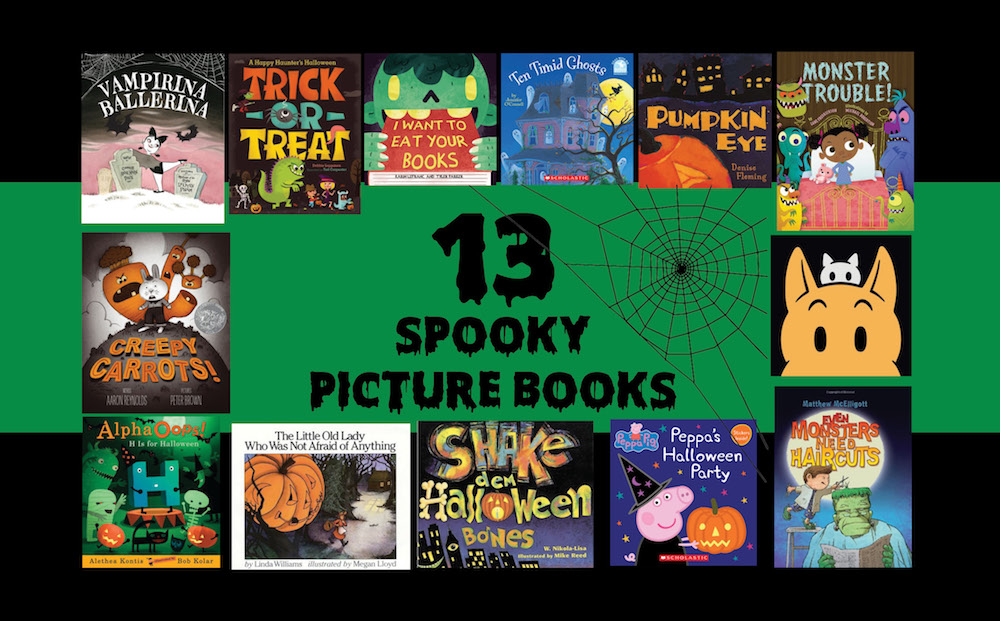
In the heat of July, my 5-year-old twin boys begged to watch The Nightmare Before Christmas every day. But I'm not complaining. There's no question that they inherited the Halloween gene from me. I obsess over family costumes, seasonal decor, beloved spooky movies, and festive treats.
I've also bought my boys more than a few Halloween season picture books over the years (and taken out way more than my fair share at my local branch library). Each fall, I open the cabinets where I store the holiday books, and stick them back on the shelves. Rotating seasonal books like this is a great way to impart a sense of the cycle of the year. It's fun to rediscover old favorites, and this excitement creates great anticipation for the approaching holiday.
Last year, I posted a list of 5 great Halloween picture books that work well for kids with autism: A Dark, Dark Tale, Pete the Cat: Five Little Pumpkins, Room on the Broom, Go Away, Big Green Monster!, and It's Pumpkin Day, Mouse!. This year, I've got 13 more for you.

Roaring Brook Press (2014); hardcover, $17.99

Wordless picture books are extremely beneficial for children with delayed echolalia (aka "scripting") issues. Adults read them differently each time (using different words and focusing on different elements), so kids with echoic language disorders are freed from "the script" and forced to interact with the books as stories.
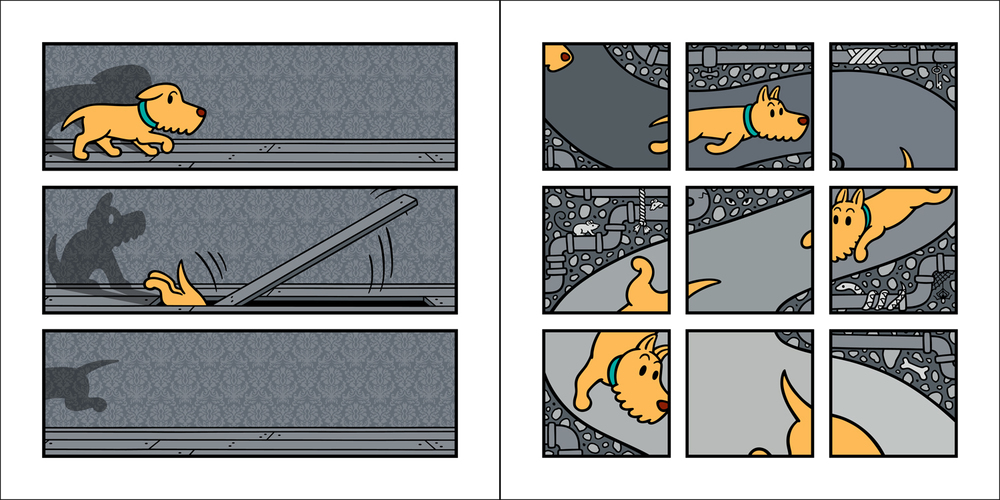
Bow-Wow's Nightmare Neighbors begins when Bow-Wow, asleep on his teal-colored doggie bed, is rudely awoken by bright white ghost cats who steal his bed! He follows the thieves across the street to a haunted house where hundreds of mischief-making ghost cats are ready to play more tricks on him.
Newgarden and Cash use a lot of different panel constructions to creatively tell this story. Page to page, the structure changes, and this may be hard for some kids. But for others, it will provide extra interest and they may even pick up on how it influences pacing. I love how the interior of the haunted house is colored in grays, while Bow-Wow is orange and the ghost cats are white. There are also no end of teal things that Bow-Wow mistakes for his stolen bed. The pop of the bright teal color is a smart choice and makes the plot really understandable.
My son Harry gets all the credit for discovering this book. He selected it for himself at the library.
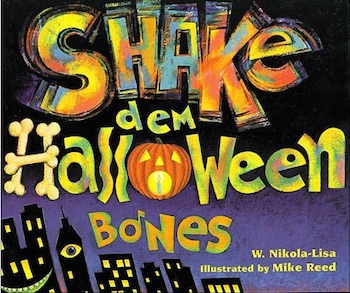
HMH Books for Young Readers (2000); paperback, $7.99

This book has everything. Eye-catching illustrations. Rhyming text with a great beat. And that awesome ingredient that is so great for so many kids with sensory issues: music.
For children who are beginning to learn about classic fairy tales, fables, and nursery rhymes, it's a real treat to see Li'l Red (Riding Hood), Li'l Jack (of beanstalk fame), Tom Thumb, Snow White, Goldilocks, Mister Pig (one of the Three Little Pigs), Rapunzel, Rumpelstiltskin, Cinderella, and Puss (in Boots) each get their very own verse in the song.
This is also a very diverse book, which is a big plus. The illustrator completely ignored more conventional white-only takes on the race or ethnicity of the familiar characters. The setting also makes me happy: I love the feeling that we are at a party in what looks to me like a New York City (or other big city) apartment. That's something my kids can relate to that doesn't show up too much.
One tiny sticking point is the "Hip-Hop Halloween Ball!" lyric. A song that begins "ah-one, ah-two, ah-one, two, three four..." and ends "Scoo-bee-doo-bee-doo-wah. Yeah!" isn't "hip hop." It sounds like Doo-Wop to me.
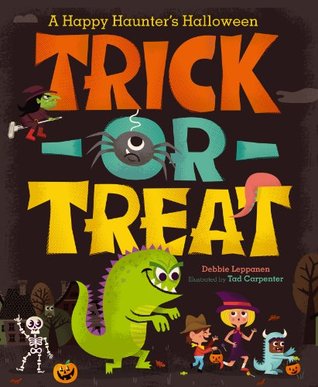
Beach Lane Books (2013); hardcover, $16.99

Fifteen very short Halloween-themed poems (of many different forms) are each presented on a two-page spread with bright and funny illustrations. The illustrations are very clean and cartoon-like, so it's easy for a child to tact (label) Halloween things and to identify what is happening in the picture.
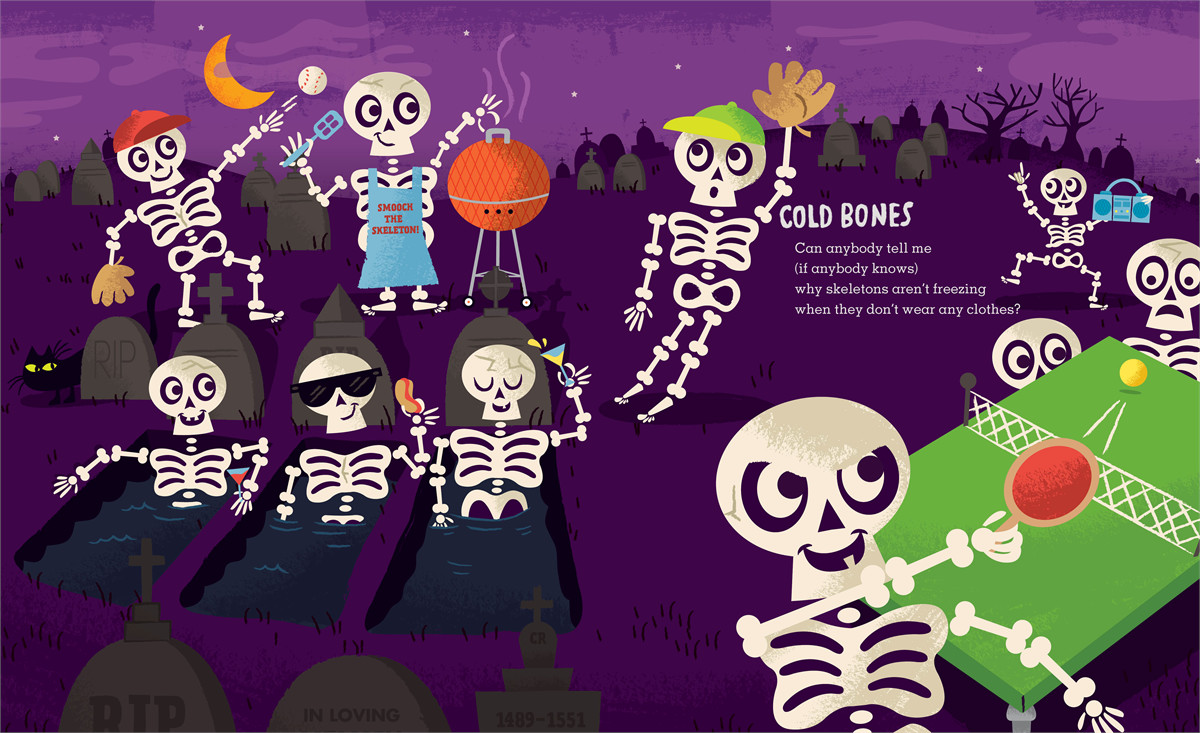
It's a lot of fun to read a poetry collection to my kids that has strong narrative and high-interest subject matter. Most poetry collections for kids are boring and abstract or include poems that are much too long for kids with distractibility issues.
These poems also have great punchlines. Harry's favorite is probably The Monster, in which a boy getting ready for bed searches his room for a monster... but forgets to check on top of his own head! Luke likes Slick Ride, in which witches are flying in the rain... on mops! Here is that poem as an example:
Slick Ride
Witches on broomsticks
fly over treetops.
Except when it rains,
then they use mops!
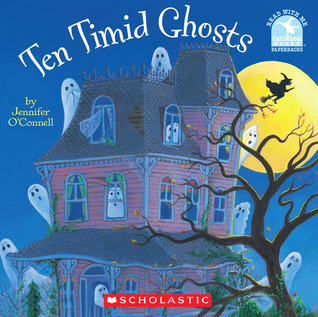
Cartwheel Books (2000); paperback, $3.99

This is a welcome re-invention of the traditional nursery rhyme, which is a catchy poetry structure for kids... but was originally horribly racist.
In O'Connell's updated version of this countdown poem, a witch moves into a haunted house and decides to trick its inhabitants, the ten timid ghosts, into leaving so she can have it for herself. She uses costumes and props to scare them.
The witch dressing up in costume and using props to trick the ghosts is a great way to practice labeling what "dressing up" or "playing a trick" means. As soon as my son Harry realized that on every page the witch tricked a ghost, he began to look for the witch and see what she was up to. My son Luke is more focused on the countdown and labeling what the ghost is doing: "Ghost scared! Ghost is leaving."
I love that there is a (ghostly) numeral next to the word for the number as we count down the ghosts on each page. That really helps kids reinforce those number words as sight words. There is also a nice subtraction concept for kids who are ready to talk about that. Each time a ghost leaves the poem adjusts the number in the last line of that stanza. For example:
Seven timid ghosts in a haunted house—
A witch moved in and wanted them out
One saw a cat
What a terrible fix!
She flew to the woods
and then there were six.
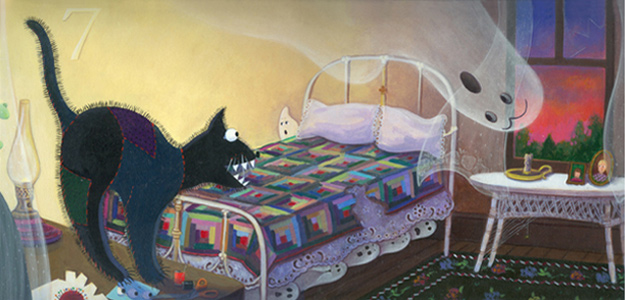
The only thing that would have made this book more perfect is if the formula (i.e. "7-1=6") appeared somewhere on the page. But I love the plot twist at the end, in which the last ghost figures out what's been happening and organizes her friends to scare the witch away. I can tell that my sons understand enough about this outcome to enjoy that the good ghosts win.
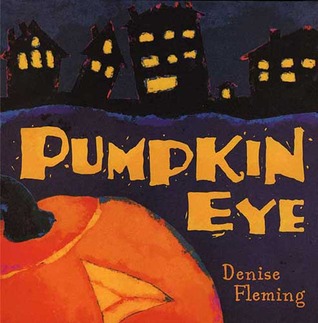
Square Fish/Macmillan (2001); paperback, $7.99

I adore the musicality of this simple prose book. Denise Fleming is probably better known for her enchanting and alluring art, but I am even more impressed with her ability to cast a kind of tranquility spell with her spare prose. Yes it rhymes and the meter is spot on, but it's more than that. Every word she chooses is right.
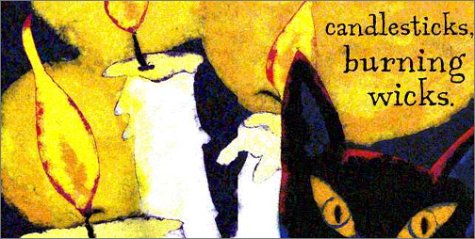
Reading Pumpkin Eye straight and talking with a child about what they see on each page is a fine way to approach this as a read-aloud. But I have found that it's incredibly easy to sing this book. I usually approach it like a Gregorian chant, although sometimes it comes out more like I'm ripping off Tim Burton's This is Halloween. My sons always try to hum along for those long notes. Here is a taste of 4 spreads of the prose, so you can see what I mean about how easily it flows:
Yellow moon
rising soon...
Piece of pie,
pumpkin eye...
candlesticks,
burning wicks.
Trick or treat—
pounding feet,
jack-o'-lanterns
line the street.
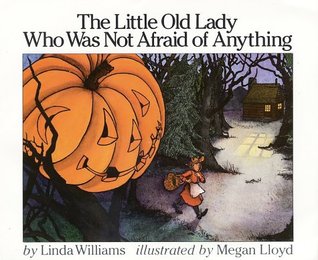
HarperCollins (2002); paperback, $6.99

The Little Old Lady Who Was Not Afraid of Anything has one of my favorite narrative structures: the cumulative structure (sometimes called a "chain story"). In a cumulative story, the action repeats, adding elements, and building up towards a highly anticipated conclusion.
Predictable stories like this are wonderful for kids with ASD because a child catches on to the repetition and it helps them pay attention and stay connected. In The Little Old Lady Who Was Not Afraid of Anything, a fearless old woman goes out to collect herbs and things for her dinner. But on her way home, she confronts a series of animated clothing items clearly trying to scare her. First there are the shoes that go CLOMP CLOMP on the path. Next there are the pants that go WIGGLE WIGGLE. And so forth.
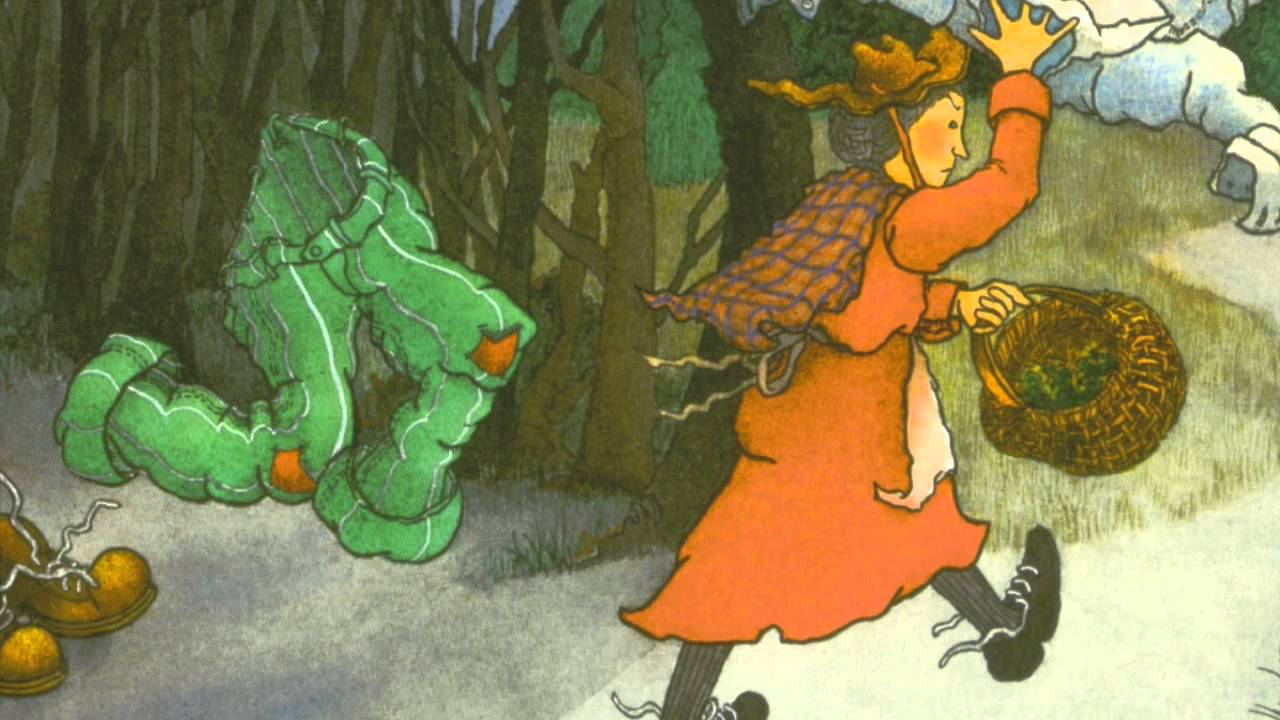
As she encounters each haunted item she admonishes it ("Get out of my way, you silly shirt! I am not afraid of you."), but the clothes collect behind her and finally when the pumpkin head appears she gets a little scared and they chase her home, each making their special noise. The clothes tell her that they are sad that she's not really scared, so the Little Old Lady helps by making them into a scarecrow.
The sound effects that are chained together as the book progresses are really excellent for sensory integration and can also work for gross motor imitation (mimicking what the clothes are doing to make the sound). This book is also great for extra practice labeling clothing and for working on basic part/whole concepts.
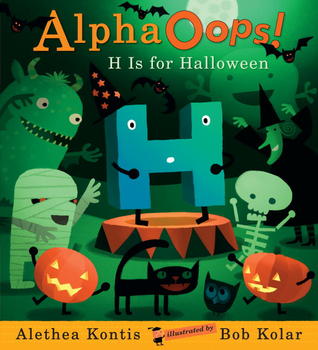
Candlewick Press (2010); hardcover, $7.99

I reviewed Alpha Oops! The Day Z Went First, in my roundup earlier this year of books about the alphabet. I like this sequel even better. Once again, all the letters are about to put on a show, but A isn't ready. This time, H is called in and gets things started with "H is for Halloween."
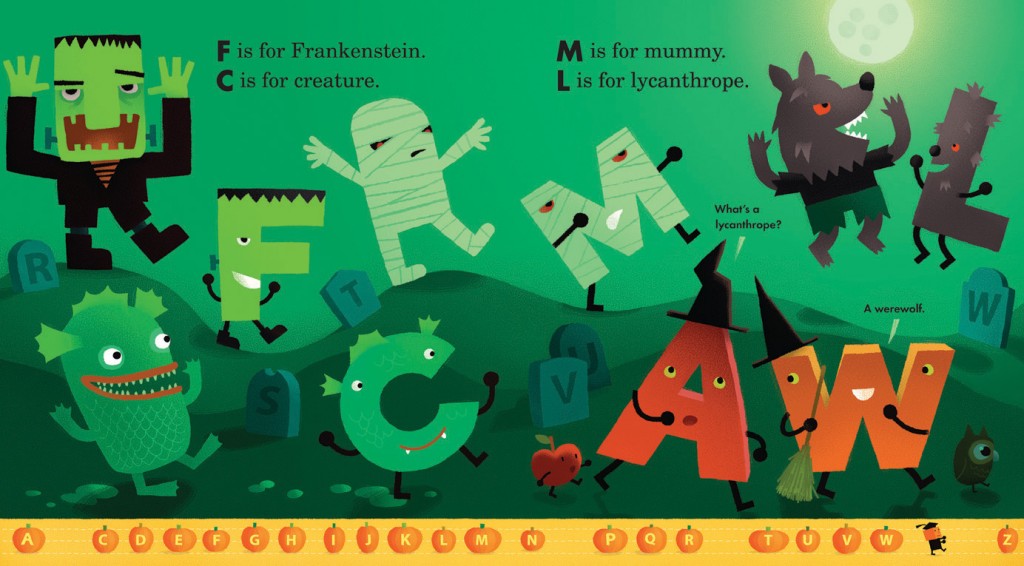
The letters all eventually take the stage dressed up as Halloween themed words, like "Z is for Zombie" and "S is for Skeleton." There are some cute running gags too. The letter B keeps getting its ideas stolen (like when it tries to dress up as a Buccaneer but P dresses up like a Pirate). But B finally has an original idea and ends the book with "BOO!"
Part of the shtick of the AlphaOops books is that the alphabet is all out of order. If you have an alphabet lover with a scripting problem, this is a great way to break that habit and help your child tolerate (and enjoy) the alphabet as a collection of useful building blocks and not just a strict, ordered chain.
But for a child who has some anxiety about this disorganization, or is too confused about this gimmick, there is a long row across the bottom of each spread where the letters that have already appeared are listed in the traditional order.
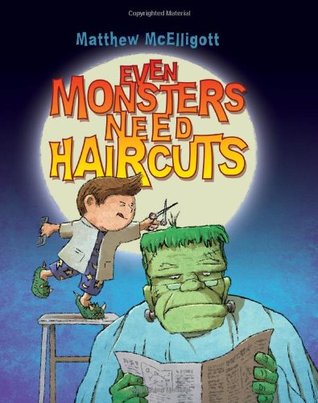
Walker & Company (2010); paperback, $7.99

It's a full moon, and a little boy sneaks out of his house at night to run his dad's barbershop as a monthly hair salon for monsters. With a nod to the parent-reader, the boy admits he isn't allowed to go out of the house alone. But he tells us not to worry: Vlad is with him. Vlad is a bat who turns into a vampire a few pages later.
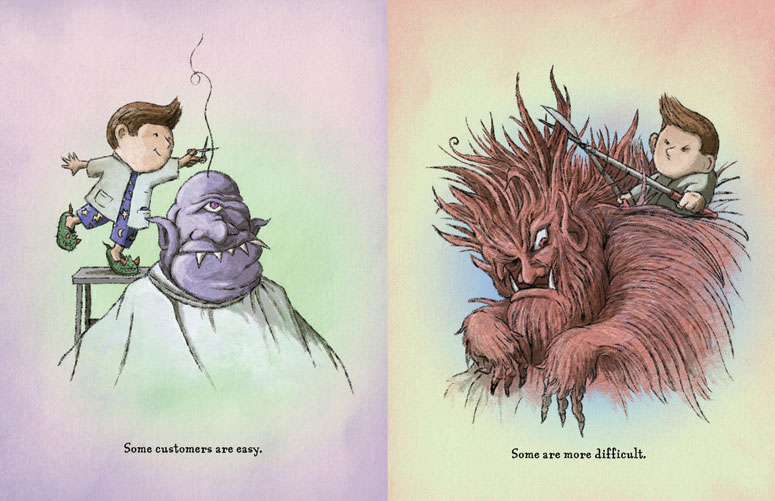
The pictures are fantastical and there are lots of details that kids will love, from the boy styling the Medusa's hair blindfolded, to him scratching his head about what to do when a skeleton slumps into the barber chair. Some pages may be too busy for kids who don't do well with visual noise (like my son Luke), but perfect for kids who like to look at cluttered illustrations and label things (like my son Harry). Many of the pages, however, have only a few characters and are set against a solid background.
This is a particularly useful book for kids who have anxiety about haircuts. It provides an opportunity for them to form positive associations with the topic. There are lots of opportunities to label things that you commonly find in a salon or barbershop (shampoo, combs, scissors, clippers, barber chairs, mirrors, etc.).
The text doesn't rhyme or repeat, but the story is told in very short, active sentences, with only a few lines on each page. My son Luke isn't able to pick up on the plot yet; it's just a bit too complicated for him. For Harry, however, it's a very funny book with so many little visual details that he discovers something new with each reading.
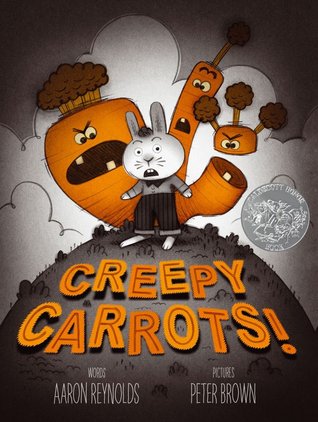
Simon Schuster Books for Young Readers (2012); hardcover, $17.99

Jasper Rabbit loves to munch on the carrots in Crackenhopper Field. But then creepy carrots start following him—or do they?
Jasper sees creepy carrots in the mirror when he's brushing his teeth, but when he turns around it's only orange shampoo bottles and a rubber duck. Later, he sees creepy carrot shadows in his room at night. But when his dad comes in and turns on the light, we can see that the shadows were cast by harmless toys. It gets worse and worse until Jasper is seeing creepy carrots and hearing their sinister tunktunktunk sounds everywhere he goes!
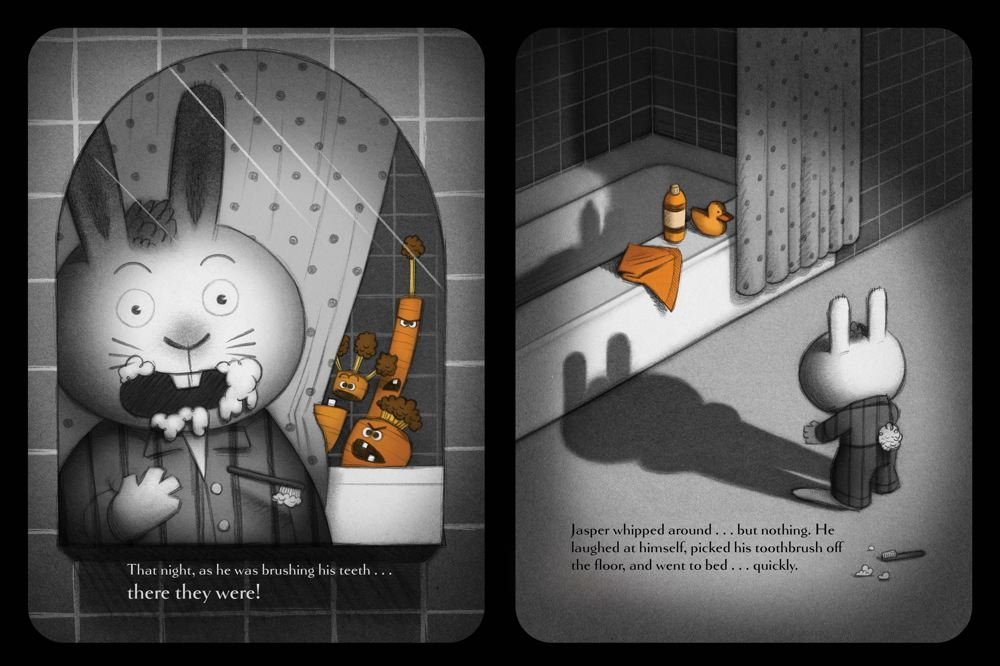
This book is one of the "scarier" ones on the list, but my sons both think it's funny. The art is great. Simple graphic illustrations in greyish graphite tones contrast perfectly with pops of bright orange.
The story ends with Jasper building a fence around Crackenhopper Field to keep the carrots in and the carrots celebrating that their plan had worked. For me, this is ending is the only miss. The message, which I think is about greed, is vague. And it's confusing that the creepy carrots are real.
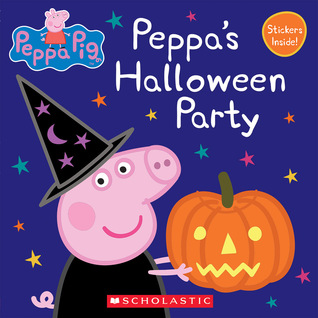
Scholastic, Inc. (2016); paperback, $4.99

I've been promising to include more books that are media tie-ins. It's too easy to fall into the trap of being a book snob. The goal is to get kids to love books and reading. Books starring favorite TV and movie characters are a great way to achieve this.
Peppa's Halloween Party works well as a simple social story about Halloween night. Peppa and George carve a pumpkin with Mummy Pig and put on their costumes (Peppa is a witch and George is a dinosaur). Their friends show up for a Halloween party that the Pig family is hosting. Kids who are familiar with all the characters will get a lot out of labeling what each familiar character is dressed up as.
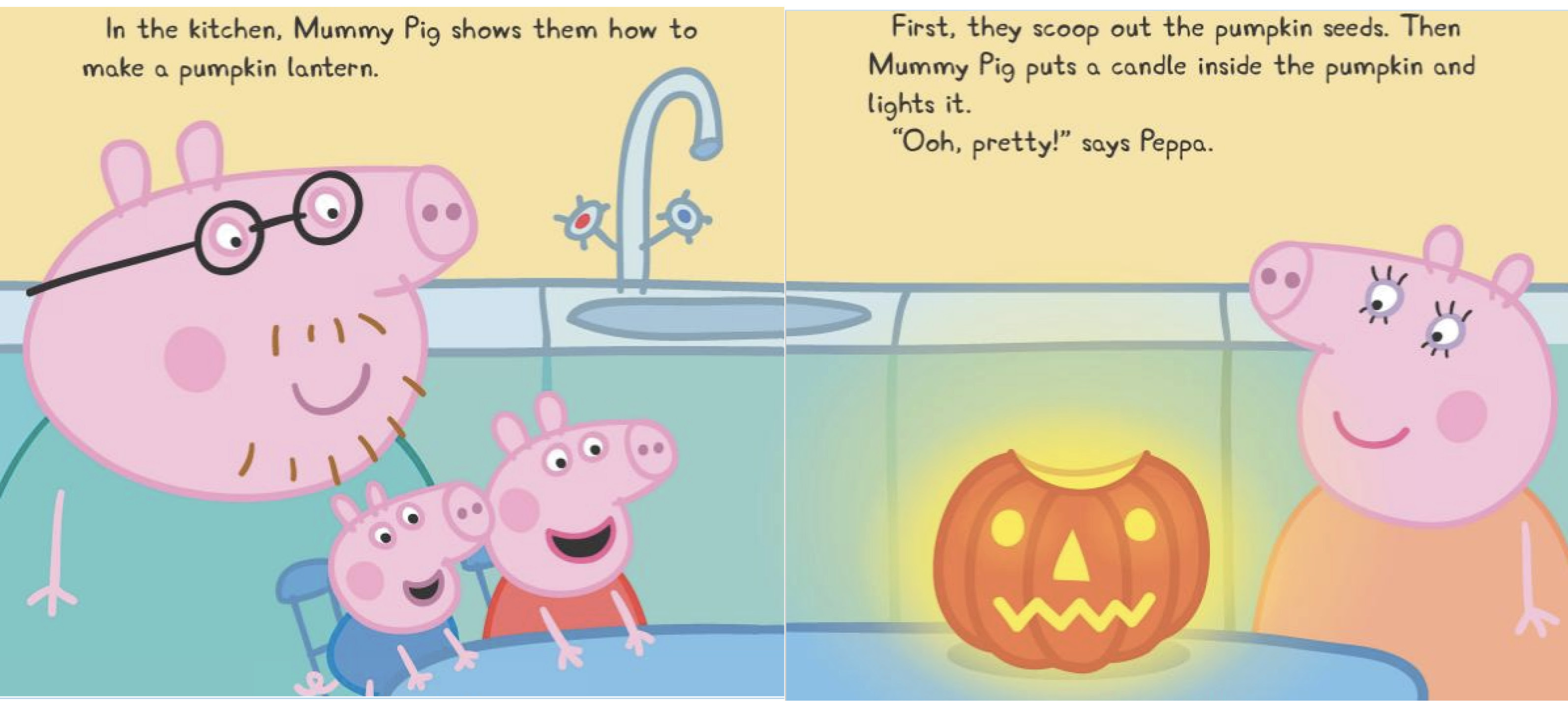
I wish the book included trick-or-treating, but the British don't consider that an essential part of the holiday (although it's gaining in popularity from what I understand). Still, the Halloween party depicted has many elements that make this a good social story with many classic costumes represented, and the pumpkin carving scene is a great way to introduce that tradition.
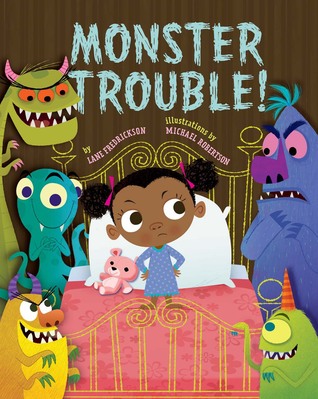
Sterling (2015); hardcover, $14.95

Winifred Schnitzel (best character name ever) isn't afraid of monsters. That's a good thing too, because at night her bedroom is infested. Her problem is explained succinctly:
But all of their monsterly mayhem was moot—
because Winifred Schnitzel thought monsters were cute.
Still, night after night, all those monsters kept creeping
into Winifred's room, interrupting her sleeping.
Winifred falls asleep in ballet, in school—even while she's trying to eat and play. So she tries setting up all manner of traps and tricks to discourage them. Nothing works until one night when she gives a monster a big, sleepy kiss and discovers... monsters hate kissing!
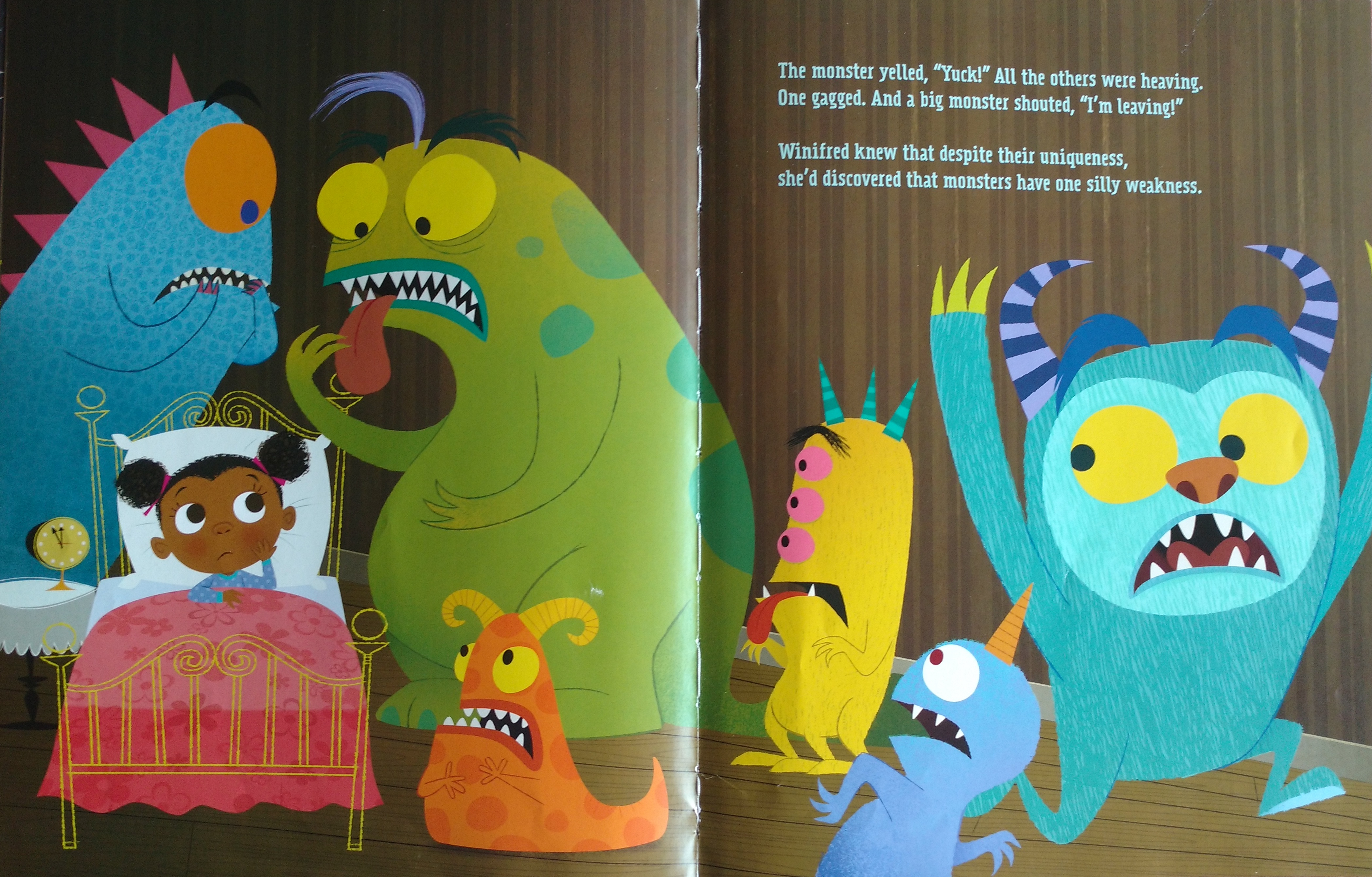
This book is adorable. Winifred is adorable. The monsters are adorable. The artistry is fun and bright and easy to look at (and reminds me strongly of Monsters Inc.—a very good thing). And the bouncy, fast-paced rhyming poetry helps anchor kids with autism to the story because it makes the book more predictable.
But I really wish the plotting had been more concrete. For instance, Winifred orders a book called "Monsters Beware!" for ideas. Her first trap, taken from this book, is the "Sticky-String, Small Monster Snare." A bottle is pictured with the word "GLUE" next to a spool of twine and we see the finished product: string stretching across her room like a web. All of this is just too abstract for my kids. Unfortunately there are other examples in the book that are similarly over their heads.
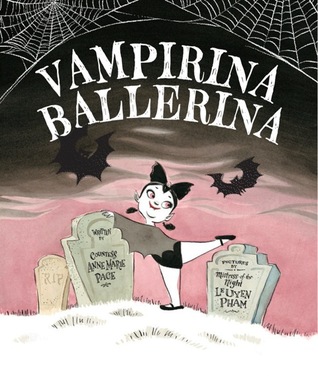
Disney/Hyperion (2012); hardcover, $16.99

Little Vampirina wants very much to be a ballerina, so her vampire parents enroll her in an evening class (of course) and take her there in the family hearse. All the other girls are in pink tutus, but Vampirina shows up in black, and her classmates are afraid of her, at first. By the end, of course, she's won all their hearts.
This is a delightful book, and the watercolor pictures are beautiful and my kids enjoy looking at them. I particularly love this book as a way to teach about vampires. They have no reflection, can't be out during the day, sleep in coffins, have fangs, turn into bats, etc. Learning about monsters is actually an important goal. They are a big part of our common language and culture.
Disney Junior launched Vampirina as an animated series on October 1st. The series is based on this book and its two sequels, so if your child loves Vampirina there is a whole world of new media to enjoy.
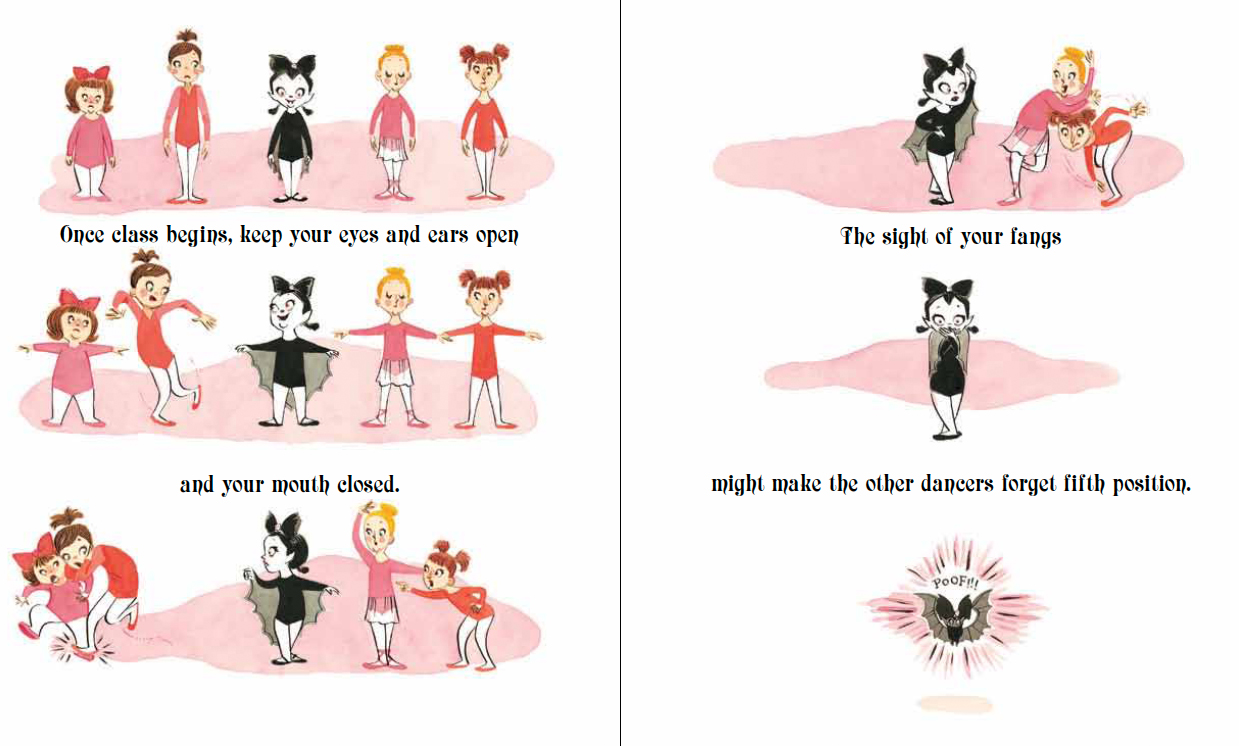
My big complaint is the heavy use of technical terminology ("fifth position," "pirouette," etc.). I did try to (badly) demonstrate these terms, and my son Harry enjoyed the story overall, but the book isn't a favorite and I'm sure this is why. But my son Luke, who has more significant receptive language deficits, just couldn't attend to it at all. I imagine a ballerina obsessed, tutu-wearing child would have far better luck. YMMV.
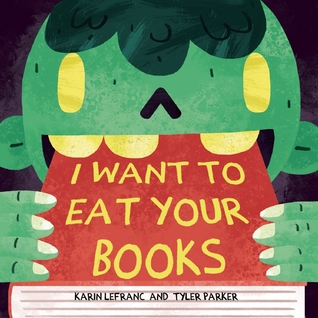
Sky Pony Press (2015); hardcover, $16.99

There's a zombie on the loose at school! But he isn't after brains—he's hungry for books. All throughout the day, the zombie boy terrorizes the school, eating their textbooks and novels and occasionally screaming (much to the delight of my kids): "I WANT TO EAT YOUR BOOKS!"
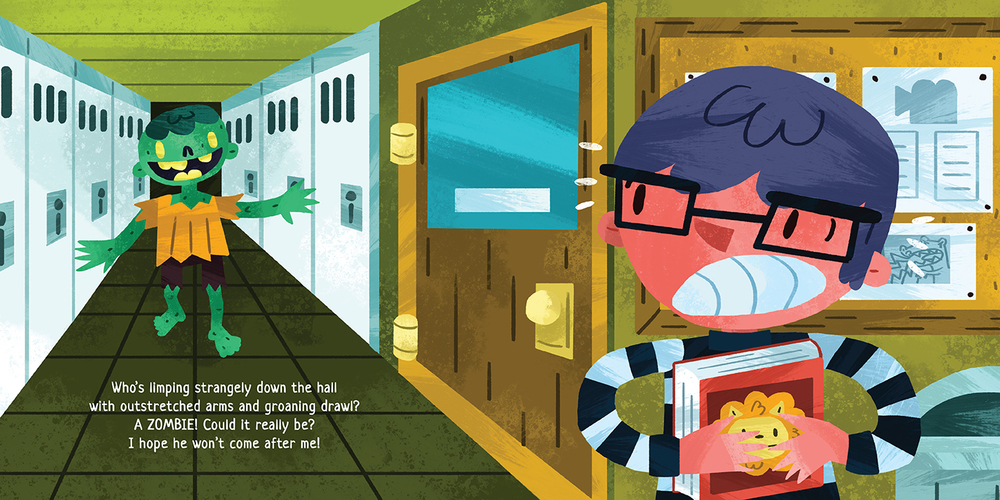
Of course, this all comes to a head in the library. Our hero grabs a book about the brain (clever) and, surprise! The zombie wants to read it.
My kids love the silly book-munching zombie, and they enjoy my monster-impression when I'm saying its lines. The rhyming poetry is a welcome structure too.
The book takes a truly odd turn when a mummy girl bursts into the library and begins tearing books apart. It's implied that she's doing this because she is coming unwound. The zombie boy helps wrap her up with bandages and this ends her rampage. The story ends with them sitting nicely reading together. This plotting is bizarre and my kids can't follow it (nor can I), but they still enjoy the silliness of this story overall.